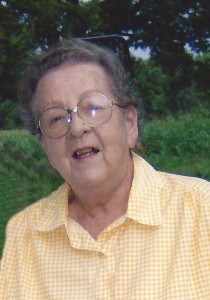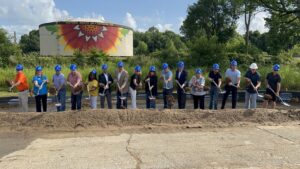
Funeral services for JoAnn (Hayes) Haag were held this past Wednesday in Sapulpa. She was the daughter of the builder and operator of popular Dixieland Skating Rink, and the niece of Clyde Hayes who built the Dixieland Park with its famous swimming pool.
JoAnn was born in Bentonville, Arkansas on June 22, 1928, the only child to Harry Hayes and Lorene (Coffelt) Hayes. That same year, the family moved to Sapulpa where Harry would join his brother Clyde in the expanding interest of the Dixieland Amusement Park and tourist cottages on historic Route 66 just west of downtown Sapulpa.
The family lived in one of the one-room cottages while Harry built a home and the skating rink.
Related: read our previous story on Dixieland
JoAnn would later work for the U.S. Postal Service as a Postal Carrier. She was married to Wayne A. Haag for 51 years. He preceded her in death. She is survived by her daughter Candice DeGraffenreid and husband Ronnie of Sapulpa; grandson Calvin Wayne DeGraffenreid of Austin, Texas; cousin Bill Coffelt of Mena, Ark.; niece Sally Harbeson; and nephew Bill Bowling.
Dixieland Park along Sapulpa’s stretch of Route 66 opened in the 1920s. Traffic from the famous highway kept the park alive until 1951. The roller rink and subsequent night spot, longer.
Chief Eaton would later acquire the property and for years use it for his salvage and wrecker business.
The skate key and piece pictured and a lot of memories is about all that remains.
Dixieland boasted a large 100 by 150 foot swimming pool and the 50 by 80 foot bathhouse. The pool is filled in with dirt from the newer Route 66 to its south. The Mother Road actually ran on the north side of the complex. The bath house is still standing and in use. Also featured were one room tourist cottages made of stucco, an auto garage and service station. There was a playground and special swimming pool for smaller children, plus a miniature golf course, barbecue pits and picnic tables and the cafe.
Dixieland Amusement Park managed to survive the 1930s dust bowl and Depression years as well as the World War II years in the 1940s, but finally had to close in 1951.
“The swimming pool had a high-diving board, and the water in that end of the pool was 18 feet deep,” JoAnn told a travel writer in an interview some years after it was gone.
“Belly-floppers shied away from the plank in the sky, but professional divers came to Dixieland specifically to try its springs,” she recalled. “One was Johnny Weissmuller. The Olympic-swimming-hero-gone-Hollywood-Tarzan was well practiced in plunging from high places and delighted in taking Dixieland’s drop.
From its outside, Harry Hayes’ roller rink looked like an airplane hanger. Inside, fine-fitted maple made up its floor. Swimming at Clyde’s pool cost ten cents, so Harry also charged skaters one thin dime.
In the 1920s, roller rinks were a new thing. Many came to Dixieland simply to see what all the fuss was about. Meanwhile, as roller skating became popular, so did Red and Donna Wilson.s cafe. Sandwiches and ribs were served up with Red’s Hot Sauce.
Buxton renamed the restaurant the Dixieland Club, and developed a more sophisticated menu featuring the likes of jumbo shrimp and fresh salmon. Such foods in these parts were not common. Buxton reportedly hired a private plane to fly the food in from the coast. People came from all over.
The glory days began to fade by the 1950s. “Clyde couldn’t keep up with the filters that the state mandated for the pool,” Haag said of the glitch that dragged Dixieland down. “Around the same time, Mr. Buxton died of cancer. The Dixieland Club closed. My aunt and uncle made that building into a home. They lived there for quite awhile.”
Although Dixieland Park closed in 1951, years afterward, Harry Hayes’ determination saw the roller rink “roll on as a solo act.” Eventually, he leased and ultimately sold the rink to Buddy Stockton who turned the rink into a night club. Things became rather rowdy. Dixieland took on a new association. The building later burned. Dixieland’s old bathhouse remains the last of the park’s standing structures.










